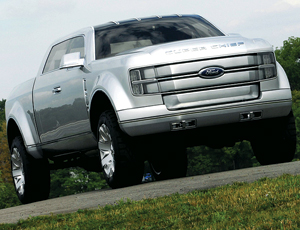President Barack Obama recently announced a new federal policy to raise the mandated average gas mileage of cars and trucks, as well as reduce greenhouse-gas emissions. By 2016, the fleet-fuel-efficiency standard for all passenger cars will be 39 mpg, and 30 mpg for light trucks and sport-utility vehicles.

The average of these two equals a passenger-car and light-truck fuel-efficiency standard of 35.5 mpg. So what does this mean for future pickup-truck buyers? It depends.
What is still to be determined are the exact rules that will have to be followed to determine fuel economy. First, it is unclear whether manufacturers will have to hit fleet-wide or segment-based goals for their vehicles. Fleet-wide goals would make it more difficult for a manufacturer to meet the fuel-economy standards if it has only a narrow choice of vehicles in its fleet (think Porsche versus Toyota). Second, it has not been decided if fuel economy will be based strictly on a vehicle’s physical dimensions or another set of attributes, such as weight or personal- or commercial-use-only designations. Still, we can make assumptions about what the pickup truck of 2016 will be like.
The current light-truck fuel-economy standards is 23.1 mpg for all SUVs, pickups, vans and crossovers. Hitting 30 mpg will require a 30% rise in fuel efficiency. A 2009 Chevrolet Silverado with two-wheel drive has a combined 17 mpg rating. That same Silverado would have to achieve approximately 22.1 mpg combined by 2016, an increase of about 5 mpg. Thus, we are likely to see an increase in the number of direct-injection turbocharged gasoline engines in the next few years and the phase-out of naturally aspirated eight-cylinder engines.

LEVINE
The new policy also increases the odds you will buy a truck with a hybrid powertrain. The two-wheel-drive 2009 Chevrolet Silverado 2-Mode Hybrid with its 6.0-liter V-8 today is rated at 21/22 mpg city/highway. Combine the truck’s batteries and electric motors with a direct-injection turbo gas mill, and you are likely to see well over 22 mpg.
Putting diesel engines in light-duty pickups does not look like a good option to hit 2016 mileage requirements. They may never arrive in the market.
The Obama administration has tasked the U.S. Environmental Protection Agency with determining a grams-per-mile limit on CO2 emissions for vehicles that fall approximately near the mileage requirements. According to a white paper released by EPA and the Dept. of Transportation, those limits will be an average of 250 g per mile for all cars and trucks. However, diesel’s CO2 emissions per gallon of fuel are higher than that of gasoline’s. A diesel-powered light-duty pickup would have to be about 15% more efficient than a gas-powered truck to meet both fuel-economy standards and CO2 emission standards. A pickup averaging a combined 22 mpg with a gas engine would have to get about 25.3 mpg if it were a diesel.
This does not mean the end of diesel pickup trucks anytime soon. A government source says the new regulations will not cover heavy-duty pickup trucks that fall in the 8,500-10,000 pound range. HD pickups are expected to continue to be excluded from CAFE consideration. A side effect could be an increase in the market share of HD pickups relative to light-duty pickups, as buyers move up to HD even though they may only need to tow and haul in ranges that a light-duty pickup truck can manage today.
The truck of the future is also likely to be more aerodynamic. Tough-truck looks will likely disappear to improve fuel economy.
One certainty in all this is that trucks will cost an average of $1,300 more to build. Anyone interested in a $50,000 plug-in hybrid truck?


Post a comment to this article
Report Abusive Comment